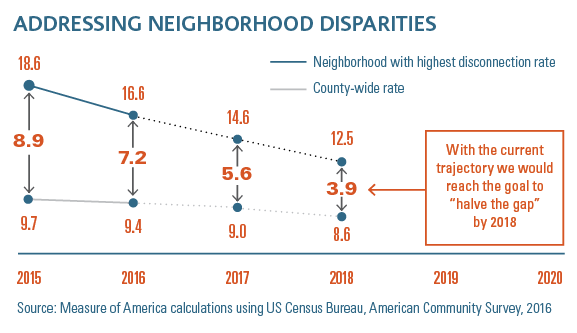
On March 15, the San Diego Workforce Partnership (SDWP) COO Andy Hall joined Measure of America Co-Director Kristen Lewis for a webinar that unveiled the latest numbers on the state of opportunity youth—young adults ages 16–24 who are not in school and not working—in San Diego County. The data is part of a collaboration between SDWP and Measure of America to assess youth disconnection, set goals and track progress in the San Diego region.
Here are surprising takeaways from the data:
1. We are not on track to cut the rate by 2020.
Though national youth disconnection continues to decline—there are 1.2 million fewer young people disconnected now versus at the height of youth connection this decade—San Diego County is not on pace to reach our regionwide goal, which is to reduce the rate of youth disconnection to 7.3% or lower by the year 2020. Although we did see a decrease in numbers, the current trajectory will not hit our 2020 goal of 7.3% at this current rate. “We’re not quite trending where we want to be, but we believe we can get back on track,” said Hall.
Additionally, San Diego County’s youth population includes more than 34,000 military personnel, meaning the civilian (non-military) opportunity youth rate is even higher than 9.4%. SDWP and MOA plan to calculate a civilian opportunity youth rate in the future.

2. We are on track to halve the gap by 2020.
2020 target: No neighborhood should be more than 4.4% above the countywide disconnection rate. This would “halve the gap” between the area with the highest rate (18.6%) and the county average of 9.7% outlined in our 2017 report, focusing efforts and resources on under-served communities. “Overall, the neighborhoods with the highest disconnection rates actually showed significant improvement in many cases…I think that’s something that we as a community can be proud about,” shared Hall.

3. Disconnection cannot be chalked up to stereotypes.
“Not all youth are experiencing reconnection in the same rates, in the same ways,” said Hall. “Through our research last year, we realized that some neighborhoods in San Diego have twice as high youth disconnection rates than the county average and when I talk about this to some folks they ask, ‘Well, who are these young people who are disconnected? Are these just millennials who are sitting on mom’s couch in La Jolla, surfing and playing video games because they don’t need to work?’ The answer from our research last year was a resounding ‘No’. The highest areas of youth disconnection came in our most underserved, low-income neighborhoods.”
4. The disconnection rate among San Diego County African American youth is 26.4%, almost three times the county average.
At 26.4%, almost three times the county average, only one other city in America has a worse African American youth disconnection rate than San Diego County. “This is something that we as a community need to be thinking hard about,” said Hall. “What interventions are happening? What systems are not working?”
5. Disconnection increases with age.
Almost all 15-year-olds are in school. As age increases between 16 and 24 more and more youth find themselves off track and neither learning nor earning. “The older you are in that 16–24 bracket, the more likely you are to be disconnected,” said Hall. “…13.1% of San Diego’s 22- to 24 year-olds are disconnected compared to just 3.7% of 16–18 year olds. That makes sense intuitively because under 18 there’s some legal requirements around attending school and post-18 there’s not. This kind of coming-of-age narrative is something that we’re going to really look at in future research.”
For more on the San Diego County youth disconnection data, watch the full webinar or explore the data.
To join the conversation on this important topic, register for Opportunity Summit 2018: Initiate happening April 12 at the Town and County San Diego in Mission Valley.
